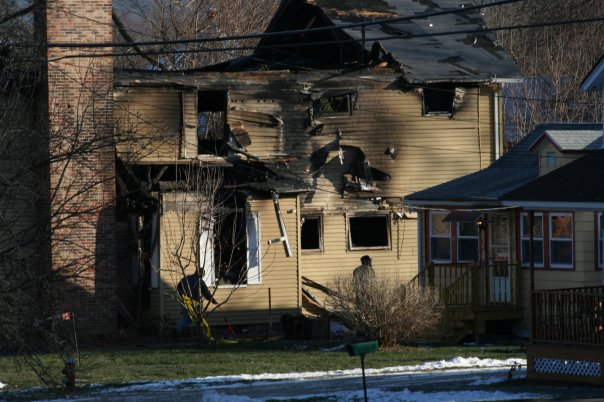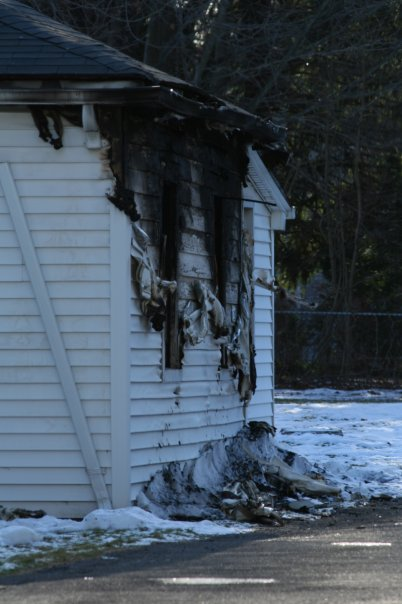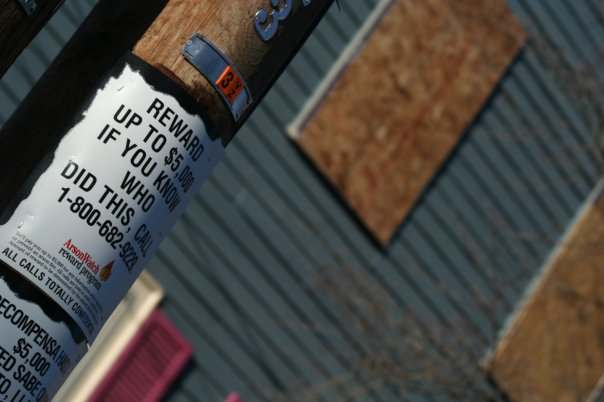Rising from the Ashes
A Massachusetts community finds renewed spirit following arson tragedy
 In the early morning hours of December 27, 2009, residents of Northampton, Massachusetts, were jolted from their slumber by the work of an arsonist on a crime spree that would end in tragedy. Set between 2:00 a.m. and 3:15 a.m., a total of 15 house and automobile fires caused an estimated $2.5 million in damages, left two families homeless, and resulted in the deaths of Fair Street residents Paul Yeskie Sr., age 81, and his son Paul, Jr., age 39, who were unable to escape their flame-engulfed home.
In the early morning hours of December 27, 2009, residents of Northampton, Massachusetts, were jolted from their slumber by the work of an arsonist on a crime spree that would end in tragedy. Set between 2:00 a.m. and 3:15 a.m., a total of 15 house and automobile fires caused an estimated $2.5 million in damages, left two families homeless, and resulted in the deaths of Fair Street residents Paul Yeskie Sr., age 81, and his son Paul, Jr., age 39, who were unable to escape their flame-engulfed home.
Shock and disbelief naturally ensued as this quiet New England town learned the scope of the destruction, yet the community refused to succumb to fear. A testament to human resilience and resolve, Northampton’s citizens, emergency responders, government agencies, and businesses quickly joined forces to rebuild their community. Today, the bonds forged by the events of December 27 are stronger than ever thanks in great part to the successful efforts of the public safety and law enforcement communities to promote crime prevention and arson awareness.
NOT a Victimless Crime
 Arson is a misunderstood offense that many associate with the debt-riddled owner who torches his business in hopes of collecting insurance money. While financial gain is a motive for some intentional fires, the majority—more than half—are committed by juveniles, often out of spite or simply for kicks. To illustrate, many communities report spikes in the number of intentional fires set by pranksters on Halloween eve and Halloween night. Arson fires also may be symptomatic of a greater social problem such as urban decay. According to the U.S. Fire Administration, drug traffickers and “urban miners” who use blighted and abandoned buildings to conduct illicit activities often loot and set fires to these structures in order to conceal criminal evidence (Topical Fire Research Series, “Arson in the United States,” December 2001).
Arson is a misunderstood offense that many associate with the debt-riddled owner who torches his business in hopes of collecting insurance money. While financial gain is a motive for some intentional fires, the majority—more than half—are committed by juveniles, often out of spite or simply for kicks. To illustrate, many communities report spikes in the number of intentional fires set by pranksters on Halloween eve and Halloween night. Arson fires also may be symptomatic of a greater social problem such as urban decay. According to the U.S. Fire Administration, drug traffickers and “urban miners” who use blighted and abandoned buildings to conduct illicit activities often loot and set fires to these structures in order to conceal criminal evidence (Topical Fire Research Series, “Arson in the United States,” December 2001).
Regardless of the motive or source, arson fires exact an enormous toll on society, in both monetary and human terms. The National Fire Protection Association (NFPA) reported a total of 30,500 arson fires set in 2008, which resulted in $866 million in direct loss (Fire Loss in the U.S.). The FBI’s Uniform Crime Reports for the same year valued the average personal loss per arson fire at $16,015 for private property, a cost which rises to $212,000 for fires involving industrial and manufacturing structures.
Even more sobering is the number of lives destroyed in the United States each year by deliberate fire. According to NFPA and FBI statistics, 315 Americans died due to arson in 2008, and 7,825 individuals were injured in 2006. Sadly, first responders figure disproportionally among the casualties of arson. One need only remember the September 11 terrorist attacks, which claimed the lives of more than 400 firefighters, law enforcement officers, and medical personnel, to comprehend the gravity of this crime.
Mobilization: Northampton’s Quick Response
The Northampton arsonist struck without warning, just two days after the Christmas holiday, and at a time when most people were asleep. Yet, thanks to an effective emergency response plan, firefighters arrived at the multiple crime scenes within minutes. “Fourteen fire departments surrounding Northampton responded directly to the various fires,” explained Northampton Fire Chief Brian Duggan. “Eleven made up two fire mobilization task forces, which were activated through the Massachusetts Fire Mobilization Plan. The Massachusetts state fire marshal’s office provided a number of resources, and the state and local police departments provided security, locked down the city, and aided in crime scene investigation.”
The investigation following the fires illustrates the benefits of effective multiple-agency collaboration. “The Northampton fire and police departments, the state fire marshal’s office, the state police, and the district attorney led the original investigation,” Duggan said. “This effort transformed into an investigation task force, which grew to include other federal and state agencies, including the ATF and some assistance from the FBI.” Thanks to numerous tips from the community and the work of the Northampton Arson Task Force, the Northampton police arrested a suspect only 11 days after the fires, and legal proceedings are now underway.
Community Outreach and Neighborhood Watch
 In the past, efforts to establish Neighborhood Watch in Northampton faltered due to budget and resource constraints. Public interest in the program resurged immediately following the fires, and law enforcement quickly organized an outreach campaign to rally the community and maintain interest. The Northampton Police Department joined forces with the Hampshire County Sheriff’s Office in a campaign to garner support on the neighborhood level.
In the past, efforts to establish Neighborhood Watch in Northampton faltered due to budget and resource constraints. Public interest in the program resurged immediately following the fires, and law enforcement quickly organized an outreach campaign to rally the community and maintain interest. The Northampton Police Department joined forces with the Hampshire County Sheriff’s Office in a campaign to garner support on the neighborhood level.
This effort has resulted in leaders from the neighborhood associations, law enforcement, the fire department, and the city council collaborating to conduct crime prevention education and Neighborhood Watch train-the-trainer meetings throughout Northampton and to reinforce the following message: “We all need to come together and work together. We need to put in place a neighborhood crime watch on every street. We need to keep vigilant and keep families safe throughout the city to carry on a normal life. We need to use our eyes and ears.”
“We got started right away organizing town meetings in local halls and churches,” said Dave Fenton, crime prevention officer for the Hampshire County Sheriff’s Office. “We partnered with the Ward 3 Neighborhood Association and invited members of their organization to serve as Neighborhood Watch liaisons.” A Department of Justice-funded arson awareness training event held in Ward 3 received a high turnout, with participants from the Northampton city government, surrounding area police departments, and officials from neighboring Hampden County joining concerned local residents. Additional meetings have since been held in Ward 6 and elsewhere. The local Rotary Club supported this initiative by offering to donate $1,000 to purchase Neighborhood Watch signage and to administer an Arson Watch reward fund and coordinate donations with the state’s initial $5,000 offering.
Technology also played an important role in the days, weeks, and months following the fires. A Friends of Northampton Facebook discussion board (today boasting more than 4,600 members) was created immediately following the fires to announce victim relief efforts and share information. Offers to donate household items and clothing, as well as to foster displaced pets and babysit children of affected families, quickly appeared on the site. Members also used this venue to advertise various fundraisers, including an indie rock concert, spaghetti dinner, and arson art benefit show, which raised thousands of dollars. Another website titled Hampshire County Cares went online in the days following the fires as a locale where nonprofit organizations could request needed goods.
Resources: Starting an Arson Watch
No community, urban or rural, large or small, is immune to crime. Arson poses a particular threat to society because devastating fires can be deliberately set by virtually anyone armed with only a match or cigarette lighter. Complicating matters is the fact that fewer than a quarter of all arson cases are solved. Incorporating an Arson Watch into existing Neighborhood Watch or other local crime prevention programs can reduce the likelihood of both accidental and intentional fires and help ensure that arsonists are brought to justice.
Crime prevention experts endorse the following five-step Neighborhood Watch-based model to develop an effective Arson Watch program: 1. Analyze the specific local problem and collect data. 2. Build a partnership between emergency services, law enforcement, and residents. 3. Assess the needs of the target neighborhood. 4. Choose and train volunteers. 5. Develop meaningful projects specific to the identified problem. Full details of the five-step model were published in the May 18, 2010, USAonwatch article titled “Setting up a Community Arson Watch Program with your Crime Watch” (see link below).
The U.S. Fire Administration’s Community Arson Prevention media kit is another excellent resource. This publication offers step-by-step guidance for starting an Arson Watch and lists a series of projects groups can implement within their communities. Additionally, the media kit addresses the unique challenges that houses of worship, schools, and businesses launching an arson watch program often face.
Neighborhood Watch meetings and training events are ideal venues for conducting basic fire prevention instruction. Simple, effective measures that all Arson Watch programs can teach include storing flammable materials outside the home and away from wooden structures and ensuring fire hydrants are accessible. Volunteer leaders can also encourage community members to install operational smoke detectors in all residential and commercial properties.
The five-step Arson Watch model stresses the importance of determining each targeted community’s unique needs. The program varies throughout the country, based largely on local demographics and topography, as the following examples illustrate. In southern California, a combination of drought, high summer heat, and wind create ideal conditions for wildfires. A 2007 Los Angeles County wildfire that consumed 38,000 acres of land and destroyed 21 homes was linked to a 10-year-old boy who admitted to having accidentally ignited it by playing with matches. Arsonists are blamed for the 2009 Angeles National Forest wildfire that killed two firefighters and caused in hundreds of millions of dollars in damages.
During “red flag” conditions, Arson Watch volunteers in southern California take an aggressive approach to prevent fires, which could quickly blaze out of control. Members of the Lost Hills/Malibu Sheriff’s Area Community Arson Watch patrol 185 square miles of terrain in private vehicles (identifiable by magnetic Arson Watch signs) using two-way radios, logging up to 4,000 total volunteer hours during drought season. Since Community Arson Watch was formed 18 years ago, only one major fire has been started in the Topanga/Malibu area. (For more information on the Lost Hills/Malibu Sheriff’s Area Community Arson Watch, visit www.arsonwatch.com/index.html.)
Twenty-three hundred miles away from Malibu, officials in Saginaw, Michigan, recently faced a rise in the number of arson cases, with indicators that the trend would continue. The recession and economic downturn created problems with urban blight, and abandoned buildings became easy targets for criminals. In 2006, concerned citizens, law enforcement, and the Saginaw Fire Department formed an Arson Watch to raise awareness of the problem and garner community support. The group has grown from 300 to nearly 650 members, who have organized street patrols and hosted arson awareness events at local schools. Last Halloween, the Saginaw Arson Watch hosted its third annual “Angels’ Night,” with volunteers helping patrol city streets for suspicious behavior. Nearly 1,000 attendees also enjoyed a fun-filled Arson Watch Halloween party designed to keep young tricksters safe and off the streets.
Eight Months Later ….
Although fear of a repeat arson attack has waned since December, Northampton and Hampshire County law enforcement leaders are dedicated to keeping momentum alive by helping residents address new crime prevention challenges. “We’re making ourselves available to anyone who wishes to participate in Neighborhood Watch,” said Captain Joe Koncas, administrator of the Northampton Police Department’s crime prevention program. “We will continue to partner with the sheriff’s office and any multiagency endeavors that may be available.”
Northampton law enforcement and fire department officials have analyzed the lessons learned during the December 27 operations in order to improve future response efforts. “On the public education and outreach side, we learned a lot in terms of how to respond to a city gripped by fear following what could best be described as a domestic terrorist attack,” said Chief Duggan. “For example, coupling our personnel with representative of the Massachusetts Corps of Fire Chaplains and providing contact on a door-to-door basis was a huge success. Furthermore, placing resources strategically throughout the community for public visibility and confidence was a success as well.”



